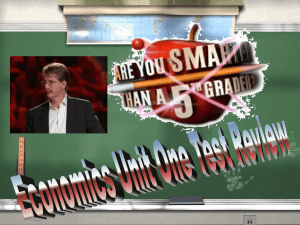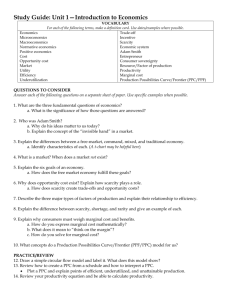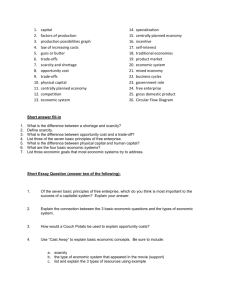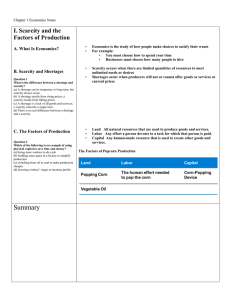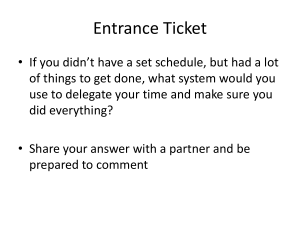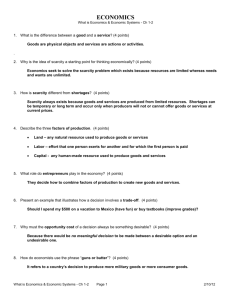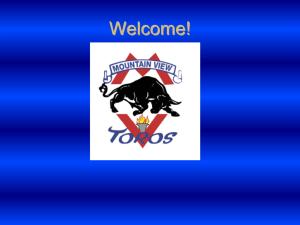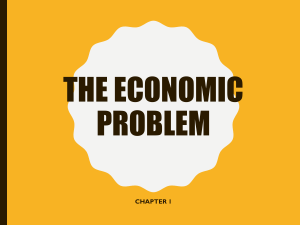What is Economics?
advertisement
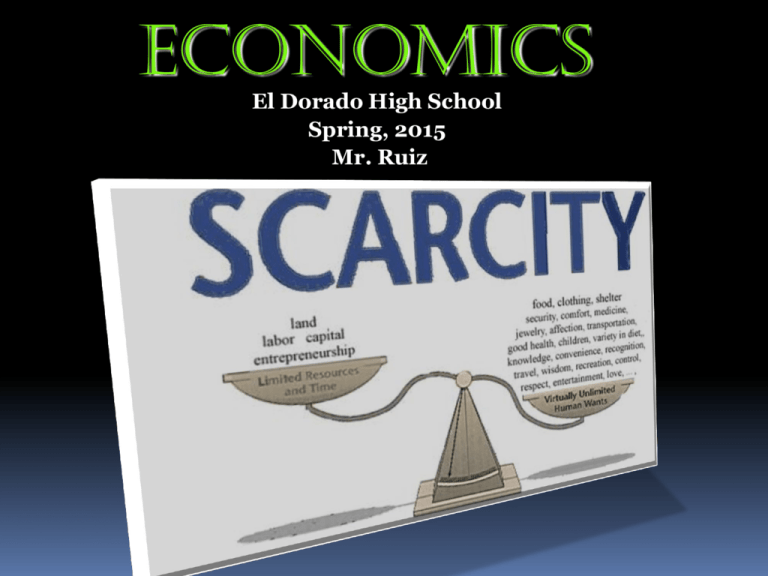
Economics El Dorado High School Spring, 2015 Mr. Ruiz Economics Chapter One What is Economics? 1. 2. 3. Section One: Scarcity and the Factors of Production Section Two: Opportunity Cost Section Three: Production Possibilities Curve Key Terms to Remember throughout This Chapter Economics Needs Wants Scarcity Shortage Goods Services Factors of Production Land Labor Capital ▪ Human Capital ▪ Physical Capital Entrepreneur Trade-off Guns or Butter Opportunity Cost Thinking at the Margin Production Possibilities Curve (PPC) Production Possibilities Frontier Efficiency Underutilization Cost Law of Increasing Costs Section 1: What is Economics? Economics is the study of how people seek to satisfy their needs and wants by making choices. Needs vs. Wants: 1. Needs: Things that are necessary for survival. (Water, air, food, shelter) 2. Wants: Things not essential for survival. (IPod, TV, cell phone, Xbox, etc..) The Economic Perspective (The economic way of thinking) Scarcity and Choice: Human/property resources are scarce. Goods and services we produce must also be limited, “We can’t have it all.” We must decide what we will have and what we must forgo. The economic axiom, “ There is no free lunch.” Scarcity vs. Shortage Scarcity: There are limited Scarcity vs. Shortage quantities of resources to meet unlimited wants. Shortage occurs when production of goods/services will not or cannot be provided at the same price; can be temporary or long term. On the other hand, scarcity exist when needs/wants exceed the resource supply. Limited quantities vs. Unlimited wants All the goods (physical objects) and services ( actions or activities performed) that are produced are scarce. Factors of Production: The (3) groups of resources used to make all goods and services (aka, Factor resources) 1. Land Natural resources (water, forests, coal, etc..) 2. Labor Efforts devoted by people to a task for compensation (payment) 3. Capital Human made resources used to produce other goods/services (2) categories: Physical capital: Buildings, tools, & machinery Human capital: Knowledge & skills gained through education & experience Entrepreneurs Entrepreneur: Ambitious individuals willing to combine the factors of production (land, labor, & capital) to create new goods and services Section 2: Opportunity Cost Opportunity cost: The most desirable alternative given up as a result of a decision. Example: Buying new shoes instead of going to the movies and dinner. The opportunity cost is the movies/dinner. Guns or Butter: Concept that explains the trade-offs countries may face. ( A country that decides to apply its resources for more military goods (guns) will sacrifice its resources devoted to consumer goods (butter) and vice versa. Retrieved from: http://www.investopedia.com/terms/g/gunsandbutter.asp Trade-Offs & Thinking at the Margin Trade-Offs: Thinking at the Margin: The alternatives that we give up whenever we choose one course of action over another. Example: If you spend more time at work, you give up spending time with your friends and/or going to see a movie. Deciding and whether to do or use one additional unit of some resource Good example provided (Figure 1.3, pg. 11) : One hour extra study time =C Two hours extra study time =B Three hours extra study time=A Production Possibilities Curve Production Possibilities Curve (Graph) PPC: Basically, shows alternative ways to make use of an economy’s resources; it help relate, (compare) the value of one thing from the value of another. An example of PPC with point A reflecting the area that is unattainable. The blue line on the graph displaying the possible combinations is know as the Production Possibilities Frontier. Efficiency, Growth, and Cost The PPC graph may point out vital information regarding the status of any given economy: It can identify if the efficiency of an economy’s resources are being maximized in the production of goods and services or recognize an economy’s underutilization of resources ( i.e., any point inside the frontier line). It can also identify unattainable production as a result of limited resources It can recognize economic growth by an entire shift to the right of the PPC It can help illustrate the cost (not in money, but in opportunity cost) of the decisions made with regards to the use of resources. Rational behavior in a world ruled by scarce resources and opportunities? “It doesn’t have to end like this!”

